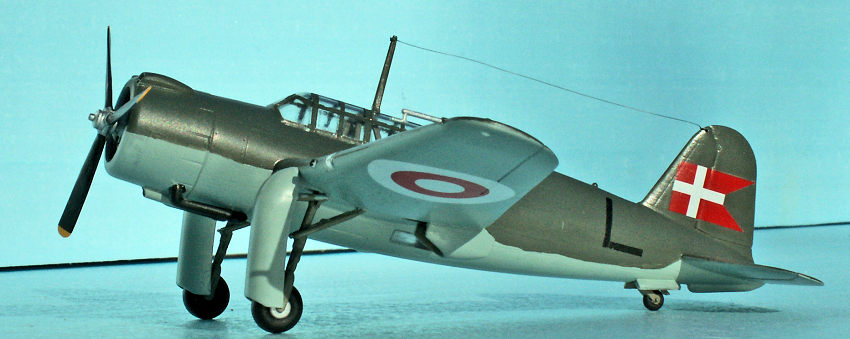
Marivox 1/72 Saab 17
| KIT #: | 3 |
| PRICE: | 106 Swedish Kronen (about $15) |
| DECALS: | Eleven options |
| REVIEWER: | Torben Plesberg |
| NOTES: | Short run kit |

| HISTORY |
The SAAB 17 was designed in the late thirties – mostly by American engineers. The original name for the project was L 10. The manufacture of the SAAB 17 started in 1939, and the first flight took place in May 1940 piloted by Claes Smith, the famous Swedish test-pilot.
The wings of the SAAB 17 were built extra strong, and this allowed the plane to be used as a dive-bomber, the Swedish STUKA so to say. The main undercarriage legs did not disappear into the wings, but were simply folded to the rear, and they were protected by big “trousers”, which had another important function: as dive-brakes during dive-bombing.
A problem during the production was the constant lack of engines. On many occasions the engines were removed after the delivery flight to the squadrons and sent back to SAAB and then build into new airframes again! The SAAB 17 was built in three versions, dependent on engines available. The A version was powered by an American Pratt & Whitney Twin Wasp. The B version was powered by a British Bristol Mercury XXIV engine license built by Svenska Flygmotor Aktiebolaget (Swedish Aero-engines Ltd.). And finally, the C version was powered by an Italian Piaggio P XI engine. These engines were obtained, because Sweden ordered 60 Reggiane RE 2000 Falco fighter planes for Flygvapnet. The Falco was powered by the Piaggio engine, and the Swedes bought so many reserve engines, that SAAB was able to power 77 B 17 C aircraft. The A, B and C versions were all light bombers with the designation B 17, just like the famous American four-engine bomber from the Boeing Company! However two more versions were produced: The S 17 BS, which was a naval reconnaissance float-plane and the S 17 BL, which was an army reconnaissance plane.
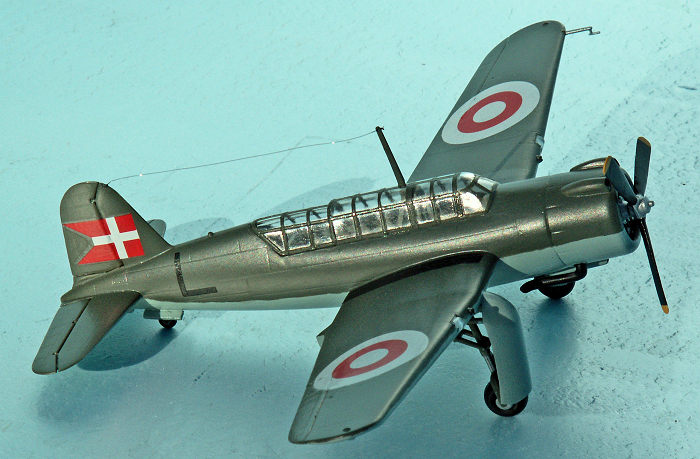 The
SAAB 17 entered service with Flygvapnet in 1942, but the coming of the jets
made the plane obsolescent after a few years. The B 17 was phased out in
1947 and the S 17 in the following year.
The
SAAB 17 entered service with Flygvapnet in 1942, but the coming of the jets
made the plane obsolescent after a few years. The B 17 was phased out in
1947 and the S 17 in the following year.
During the last years of the Second World War, the Danish Brigade was formed in Sweden, and it consisted of 15 pilots of the armed forces in Denmark, who were refugees in Sweden. The education of the Danish pilots to fly the SAAB B 17 took place with the F 7 wing at Såtenäs on the southern bank of the Vänern, the largest Swedish lake. At their disposal were 15 SAAB B 17 C dive-bomber aircraft, and the purpose of this small force was to fight against the Germans in Denmark, if they were not willing to surrender, when the war ended. However, the Germans did surrender - with the exception of the forces on the island of Bornholm – however, the Danish government did not allow the planes to land on Danish soil, and the well trained pilots were extremely disappointed, when they were ordered to take the train back home to Denmark!
Later the Danish government was offered to take over the 15 planes + spare parts and engines + radio communication vehicles + gasoline for the sum of 2 million Danish kroner. However, this offer was rejected by the Danish government. The German commander of Bornholm would only surrender to an allied officer with a higher rank than himself (Colonel). It lasted some days before a British major general was flown to Bornholm to accept the surrender of the German Commander. In the meantime the Russians had bombed two cities on the island, and they (Stalin!) decided to occupy Bornholm. It was not until late in 1946 the Russian troops left Bornholm again. The troops behaved very well during their stay, and many friendships between Danes and Russians were of a permanent character.
After the phasing out of the SAAB 17 from Flygvapnet, some planes continued in civil service as target tugs, in Sweden, Finland and even Austria. Ethiopia bought 46 B 17 A, and the aircraft were delivered by Swedish pilots to an Ethiopian air force base. The planes were delivered in three batches, and the transfer pilots were flown back to Sweden by a civil contractor in a civil transport plane. However, one of these return-flights ended in tragedy: The Bristol Freighter aircraft hit a mountain in Italy south of Rome, killing 21 out of 25 persons on board. This was the greatest loss of Swedish pilots ever.
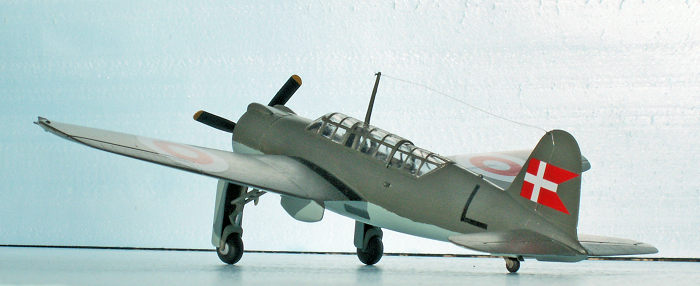 Svensk
Flygtjänst operated the SAAB 17 well into the sixties. On the occasion of
the great Swedish airshow at Malmen in 1962, one of the S 17 target tugs had
been painted in the colors of Flygvapnet, and this plane was shown in the
air. The registration of this plane was SE-BWC, and it can be seen to day in
the Technical Museum at Elsinore, painted as one of the planes of the Danish
Brigade 5 May 1945. However, it is not a plane from the Danish Brigade,
because they flew the C version with Piaggio Engine, two intakes on the top
of the cowling and without a spinner. The propeller tips were yellow, not
white with a red stripe in the middle, and they did certainly not have a
Pratt & Whitney logo on the cowling!
Svensk
Flygtjänst operated the SAAB 17 well into the sixties. On the occasion of
the great Swedish airshow at Malmen in 1962, one of the S 17 target tugs had
been painted in the colors of Flygvapnet, and this plane was shown in the
air. The registration of this plane was SE-BWC, and it can be seen to day in
the Technical Museum at Elsinore, painted as one of the planes of the Danish
Brigade 5 May 1945. However, it is not a plane from the Danish Brigade,
because they flew the C version with Piaggio Engine, two intakes on the top
of the cowling and without a spinner. The propeller tips were yellow, not
white with a red stripe in the middle, and they did certainly not have a
Pratt & Whitney logo on the cowling!
| CONSTRUCTION |
Before putting the model together it is important to know exactly which aircraft you want to model. When you have taken your pick, look carefully in the instructions and learn which parts you need for your model. Then take the parts you need from the sprues. If you don’t do that, it is easy to get confused because of the many options.
I had decided for a B 17 C of the Danish Brigade. For this model I needed the wheel undercarriage, the Piaggio Cowling with two intakes on the top, the twin exhausts for the bottom of the cowling and a left turning propeller with spinner no 76, which actually is just a small pin. I wanted a closed canopy, and did not need the rear gunner’s “bullet sprayer”, the Swedish word for MG.
Before putting the fuselage halves together, the interior must be painted,
and the assembled cockpit interior must be glued in place in the right (or
left) half, including instrument panel. The transparent windows (parts 03
and 04) must be filed to fit properly and glued in place with clear varnish.
The internal color is RLM 02 Grey. The large canopy won’t fit unless you cut
the top of the antenna basis(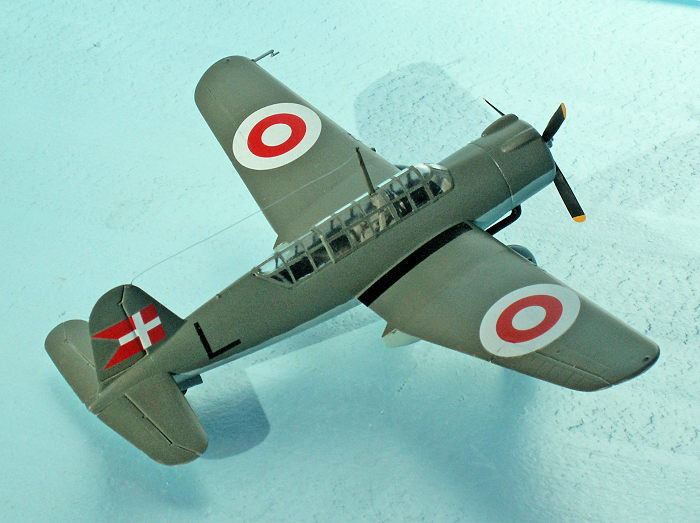 59)
and sand the new top in a curve to conform with the inner profile of the
canopy. The rear canopy must also be sanded to fit to the inner side of the
front canopy.
59)
and sand the new top in a curve to conform with the inner profile of the
canopy. The rear canopy must also be sanded to fit to the inner side of the
front canopy.
The opening of the cowling (64) front is too small, 12 mm gauge. I put the cowling in the lathe and made the opening 1.7 mm larger, and now it looked right compared to the photo documentation. The propeller blades were too narrow by more than 1 mm. So I cut the blades off from the hub, made some new ones from 0.5 mm plastic card, cut slots in the hub for the new blades and glued the blades in place. However, the blades were too thin at the hub, and I made some filling with white glue (5 times in the least) and finally with some model filler. After sanding with grain 100 and 1000 the propeller blades looked right, just like the propeller on the real thing. It is not an easy job to modify a propeller! But I would not be satisfied with a finished model showing some wrong propeller.
After the assembly of the fuselage, and wings and tail planes were added, there were only some small fillings in the joints to take care of. The ailerons and elevators were too thick and must be sanded thinner by about 0.5 mm to match the thickness of the wings and tail planes. During this process some of the fine recessed lines will disappear – and it is up to you to re-scribe them or not. I don’t find the fine lines on the ailerons and elevators important.
More important is the look of the engine cowling with its two intakes and exhausts. The intakes are far too big – and wrongly shaped. They need to be corrected – after being glued in place. It is obligate to have some photo documentation to be able to make these details look right. The exhausts (68+69) were rather wrong. The outer end of the exhausts turn 45 degrees downwards. This must be cut and turned 45 degrees upwards, that is perpendicular with the vertical center line of the fuselage.
 The
undercarriage is quite unique with the large double function “trousers”.
When the gear is up, they protect the undercarriage legs, and when the gear
is down, they act as dive-brakes! The real Stuka has a fixed undercarriage
and separate dive-brakes, the B 17 lowers its undercarriage just before a
dive bombing attack. This means that the SAAB B 17 must be able to lower the
undercarriage even at high speed. Fixing the undercarriage in the right
place is a piece of cake, when you have grasped the purpose of the four
small and thin triangles in the undercarriage area! The doors for the tail
wheel turn outwards + 45 degrees, more likely 60 degrees, and they are far
too thick. 0.3 mm plastic card would be more suitable.
The
undercarriage is quite unique with the large double function “trousers”.
When the gear is up, they protect the undercarriage legs, and when the gear
is down, they act as dive-brakes! The real Stuka has a fixed undercarriage
and separate dive-brakes, the B 17 lowers its undercarriage just before a
dive bombing attack. This means that the SAAB B 17 must be able to lower the
undercarriage even at high speed. Fixing the undercarriage in the right
place is a piece of cake, when you have grasped the purpose of the four
small and thin triangles in the undercarriage area! The doors for the tail
wheel turn outwards + 45 degrees, more likely 60 degrees, and they are far
too thick. 0.3 mm plastic card would be more suitable.
The antenna mast (26) does not fit into the slot in the roof of the canopy. The base of the antenna must be filed very much down to fit the small square slot. If you have a 0.1 mm gauge wire it looks well if the model shows the wire between the mast and the fin. But such thin wires are not easy to handle and fix properly.
| COLORS & MARKINGS |
As mentioned the interior, the wheel wells and the undercarriage legs are RLM 02 Grey. Wheel tires, propeller blades and exhausts are matt black. Propeller tips are yellow - standard for Swedish military aircraft, and not white with a red stripe in the middle. This is the standard of Svensk Flygtjänst, and the Swedes forgot this fact, when the SAAB 17 was delivered to Denmark in 1970! Therefore the SAAB 17 of the Technical Museum has the wrong color propeller tips! Engine is silver with a thin coat of gun metal. The underside is RLM 65 light blue-grey, and the upper side is RLM 71 dark green. There is no dark green ring in front of the cowling, as shown on the museum B 17, another mistake.
 The
decals are first class, and the position is shown on the bottom of the box.
If you have photos of the Danish B 17 from the Technical Museum in Elsinore,
you could get some wrong ideas. The very large non-standard national
roundels are placed far too close to the undercarriage. The correct place
seems to be the gauge of one roundel from the wing tips, both on the
underside and the upper side of the wings. There is certainly no Pratt and
Whitney marking on the cowling of the Italian Piaggio engine! The roundels
should be pushed down in the gap between the wing and the ailerons. Likewise
the large Danish flag on the fin and rudder.
The
decals are first class, and the position is shown on the bottom of the box.
If you have photos of the Danish B 17 from the Technical Museum in Elsinore,
you could get some wrong ideas. The very large non-standard national
roundels are placed far too close to the undercarriage. The correct place
seems to be the gauge of one roundel from the wing tips, both on the
underside and the upper side of the wings. There is certainly no Pratt and
Whitney marking on the cowling of the Italian Piaggio engine! The roundels
should be pushed down in the gap between the wing and the ailerons. Likewise
the large Danish flag on the fin and rudder.
To distinguish between the individual aircraft they were marked with large black letters on the fuselage sides just in front of the fin. Since there were fifteen aircraft, one can assume that the letters would be from A to O. An original photo taken on 5 May 1945 shows two aircraft in a long row showing E and F. The museum aircraft has an E. My model got an L, the easiest letter to make apart from an I. My L was made of some matt black decal paper, which I bought in 1962.
| CONCLUSIONS |
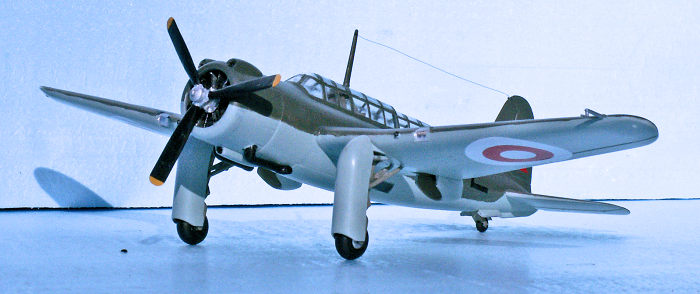 Modeling
a SAAB B 17 C of the Danish Brigade configuration 5 May 1945 is not the same
as modeling the SAAB 17 A exhibited in the Technical Museum in Helsingør
(Elsinore)! But of course you may model the museum aircraft – your choice.
Because I am a Dane with a great interest in history, especially the
occupation of Denmark from 9 April 1940 to 5 May 1945, I choose to model the
B 17 C of the Danish Brigade. But a seaplane S 17 BS or a civil target tug
are very interesting alternatives, and I might do this once in the future.
The kit is a short run kit, however, very recommendable because of its many
options – and low price!
Modeling
a SAAB B 17 C of the Danish Brigade configuration 5 May 1945 is not the same
as modeling the SAAB 17 A exhibited in the Technical Museum in Helsingør
(Elsinore)! But of course you may model the museum aircraft – your choice.
Because I am a Dane with a great interest in history, especially the
occupation of Denmark from 9 April 1940 to 5 May 1945, I choose to model the
B 17 C of the Danish Brigade. But a seaplane S 17 BS or a civil target tug
are very interesting alternatives, and I might do this once in the future.
The kit is a short run kit, however, very recommendable because of its many
options – and low price!
| REFERENCES |
Wikipedia. Org.: Articles on SAAB 17 both in English and Swedish. The English article states wrongly, that the Danish Brigade had 15 SAAB 17 A planes at their disposal. The author seems to deduce this from a photo of the SAAB 17 A of the Danish Technical Museum at Helsingør.
Internet article on the Danish Brigade 1943-45, especially concerning the SAAB 17 C squadron, and three photos of the aircraft taken 5 May 1945.
My own photos of the existing B 17 aircraft in Denmark and Sweden.
Torben
Plesberg 17 April 2017 Copyright ModelingMadness.com If you would like your product reviewed fairly and fairly quickly, please contact the editor or see other details in the
Note to
Contributors. Back to the Main Page
Back to the Review
Index Page
Back to the Previews Index Page